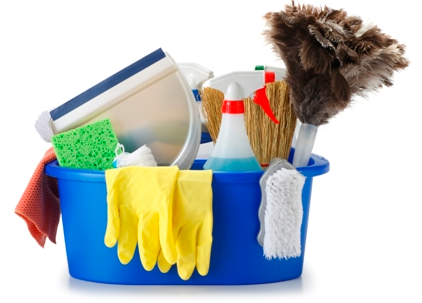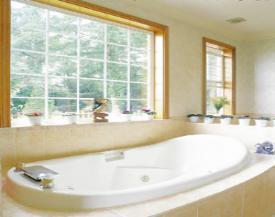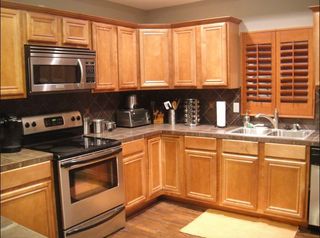Wood Floors
Never wet mop, Never clean with oil soap, Never coat with acrylic dressing, like Mop
and Glow,
or apply past or liquid wax to a polyurethane surface floor. You can only damp mop
with glass cleaners like Glass Plus and Windex. You can't buff or polish these floors
either. When cleaning, you are cleaning the polyurethane, not the wood. Think of the
floor surface more as a window or a mirror, if it will streak glass don't use it.
Acrylic based Products like MOP AND GLOW FOR WOOD FLOORS will harm your
floor,THE SHINE WILL BE REPLACED WITH A CLOUDY APPEARANCE,if you find
yourself in this situation call us at 636-410-5060 and we can refer you to a company
that can refinish the floor at a reasonable rate
It's always a good idea to check with a flooring specialist for information on cleaning
wood floors because certain treated flooring requires specific cleaning methods.
However, one general wood-floor cleaner is a solution of 1/2 cup of vinegar in 1
gallon of warm water. Use a soft cloth with most of the moisture squeezed. Get on
your hands and knees and wipe the floor without getting it wet. Then buff with a soft
dry cloth to bring out the luster.
Heel Marks
Use a pencil eraser on black heel marks.
Thanks to Melisa Maker from cleanmyspace.com for this great video
Vinyl Floors
Sweep and damp mop using a gallon of water and a dash of dishwashing detergent,
regularly to keep abrasive soil off the surface. Scrub as needed with a white nylon
backed sponge to loosen stubborn, ground in soil. Nothing cleans as well as doing it
on your hands and knees when you have time. Even no-wax floors eventually need
waxing, this will help to prevent further deterioration.
Cleaning Rusty Tile
Rust stains on tile can be removed with kerosene.
* Before cleaning bathroom tiles, run the shower on hot for five minutes to steam the
dirt loose.
* For stubborn stains, apply a paste of scouring powder and water and let sit for five
minutes. Scrub with a nylon scrub pad, rinse and wipe dry.
* To keep the grout joints on tile countertops clean longer, wash with a solution of 1
to 2 tablespoons chlorine bleach in one quart of water. Dry thoroughly, then apply
an acrylic sealer or three coats of lemon oil. Let dry one hour between coats.
* Remove mildew and make tiles sparkle by sponging with a solution of ammonia and
water.
Easy Bathroom Cleaning
Clean after a steamy bath or shower. The walls, fixtures, etc., will be much easier to
clean because the steam will have loosened the dirt.
Cleaning the Sink
* For light stains, rub with a fresh cut lemon.
* For dark stains (like rust) rub with a paste of borax and lemon juice.
Bathtub Rings
* To avoid bathtub rings, don't use oily bath preparations. Use a water softener if
you live in a hard-water area. Rinse the tub immediately after bathing.
* If a ring does form, wipe it off with undiluted ammonia (wear rubber gloves) or a wet
sponge generously sprinkled with baking soda. Rinse clean and wipe dry. For a
more stubborn stain, scour with automatic dishwashing detergent or rub with a cloth
dipped in vinegar.
Cleaning with Rubbing Alcohol
Rubbing alcohol will clean the caulking around bathtubs. It also shines chrome and
glass. Liquid chlorine bleach (1/4 cup to one gallon) will also clean caulk.
If you have a small bathroom or a tile entrance and don't have time to bother with a
scrub bucket, just use an all purpose spray cleaner and a damp sponge for quick
clean up.
Mildew
To remove mildew from the corners of the tub, dip cotton balls in bleach and let them
sit, when you finish cleaning the bath, remove cotton and rinse well. The mildew will
be gone.
Disinfectant
Clean with a disinfectant to kill germs. Everything in the bathroom except the mirror
can be cleaned this way in just 3 or 4 minutes a day. Keep cleaners in bath for a
quick job when unexpected company drops by.
Shower Tile
Remove soap and hard water buildup on shower tile with tile cleaner. Then apply a
good paste wax and buff with a dry cloth to deter future water spots.
Air Freshener
For immediate air freshener in the bath, place a fabric softener sheet in the
wastepaper basket or add a dab of fragrance on a light bulb. When the light is on,
the heat releases the aroma.
Freshen Drain
To freshen drain, pour 1/4 to 1/2 box of baking soda down the drain, add 1/2 cup of
white vinegar. Cover drain tightly for a few minutes and flush with cold water.
Shower Doors
* Rub glass shower doors with a white vinegar-dampened sponge to remove soap
residue.
* To clean shower track door, pour full strength vinegar into the track, let soak for a
few minutes, then rinse.
* A coat of acrylic floor finish gives new shine to fiberglass shower doors and makes
water spots disappear. Club soda will give new shine to your counter tops.
Cleaning Shower Curtains
* Before hanging shower curtains, soak in salt water solutions to prevent mildew.
* To remove mildew, wash in hot soapy water, rub with lemon juice and let the
shower curtain dry in the sun.
* For plastic curtains, clean with laundry pre-wash spray. Spray along the top, letting
it run down to cover the curtain. Allow it to sit for a few minutes, then rinse it off.
Sparkling Sink
Wipe a stainless steel sink with vinegar or a touch of oil on a cloth to make the sink
sparkle.
Cleaning Toilet Bowl
* Clean the toilet bowl while you're away by pouring in 1/4 cup bleach and leaving it
until you return.
* Keep the toilet bowl ring-free by pouring a half-gallon of white vinegar in it once a
month. Let it soak overnight before flushing.
* Don't use bleach if you're already using a tank-held cleaner that's released when
the toilet is flushed. The two may react chemically.
* To avoid clogging and odors, pour one cup baking soda down the bowl weekly.
Clean Doors Give a Great Impression
If company is coming, clean and wash the doors in your house. No one knows why,
but your whole house looks good. Scrub the door from top to bottom with a rag and
soapy water, using a scrub brush for especially tough spots. While you're at it, wipe
down the top edge of the frame. With all the dust that collects up there, it probably
looks like velvet. Along with the upper side of a ceiling fan, the top of the door is one
of the most missed spots in the home.
Best Way to Tackle Cleaning
Look at each room and identify specific tasks. Make a list of cleaning priorities.
Share the fun with family members.
* Kitchen: wash and wax wood floors and mop vinyl floors. Clean out refrigerator and
pantry. Change shelf-liners. Straighten junk drawer Wipe down cabinet.
* Bathroom: Use lint-free cloths or a squeegee to wash windows inside and out. Dust
the sill. Vacuum the window well.
* Window Treatments: Vacuum draperies. Wash blinds. Replace heavy drapes with
lightweight or sheer curtains.
* Furniture: Polish furniture, wash upholstery, vacuum between cushions. Clean
behind and under sofas and cabinets.
* Closets: Give old clothes and furniture to charity. Vacuum floors. Dust shelves.
Hang cedar blocks to freshen the areas.
* Always start at the top of the room and work your way down.
* Always clean top to bottom. When you dust, start at the top and work down.
* Take all your cleaning tools with you into each room to avoid unnecessary trips
back and forth.
* Unplug the phone and the turn off the T.V.
* Eliminate clutter. An uncluttered home looks better than one that is dust-free but
strewn with odds and ends.
* Clean as you go! It takes a lot less time to remove new dirt than old, and to clean
and put away stuff as you use it, than to clean and store the pile-up you can
accumulate.
* A house that smells fresh will give the impression of cleanliness. Leave baking
soda on carpeting for the night to absorb musty odors, vacuum in the morning.
* Keep a big astro-turf mat on the porch to cut down on tracked in dirt.
* Keep a basket in the kitchen for the mail, newspaper, car keys to help with clutter.
* Keep a hamper in every bathroom.
* Make everyone in charge of making his or her own bed and picking up their stuff.
* Always pickup the T.V. room before bedtime and start the dishwasher.
* Prioritize, if your time is limited decided what is most important.
* Delegate, get the entire family involved.
* Make a checklist, when a job is completed, check it off - you'll feel as though you
are really accomplishing something.
Cleaning Windows
* If necessary, dust off the window and sill with a clean paintbrush. Excess dust and
water can cause mud.
* Use a professional-type squeegee available for about $20 at a janitorial supply
store. Forget the cheap brands you find at the grocery store. They are not as
effective, and you have to replace the whole thing once you get a nick in the blade.
* Don't clean windows while they are in direct sunlight. Your cleaning solution will dry
too fast.
* Dip a 100% cotton cleaning cloth in your solution. Wring out the excess and then
wipe the window to loosen dirt.
* Grab your squeegee. Start each squeegee stroke in a dry spot. Wipe a strip with a
cleaning cloth to get started.
* Squeegee in a pattern from top to bottom, or side to side. If you clean the outside
and the inside, Work top to bottom on the inside and side to side on the outside. By
doing this, you'll be able to identify which side any streaks left behind are on.
* Keep the squeegee blade dry by wiping it with a cleaning cloth after each stroke.
* Replace the blade when necessary. Even the smallest nick can cause streaking.
* Don't have a squeegee? Use newspaper for drying freshly washed windows. It's
cheaper and leaves no lint behind.
More Window Washing Hints
Wash windows on a cloudy, but not rainy day. This is the best time to vacuum the
frames and sills. Cool, clear water is the choice of most professional window
washers. If windows are very dirty you can add 2 to 3 tablespoons of vinegar per
gallon of water. For drying windows, a wad of crumpled newspaper works just as well
as expensive paper towels.
Cleaning Miniblinds
* Slip your hands into a pair of socks for cleaning the miniblinds. Dip one hand into a
bucket of warm, soapy water and hold the blinds between your two hands. Rub back
and forth until you've cleaned the whole surface. Then reverse sides so the dry sock
dries the blinds.
* Wipe miniblinds with damp fabric softener sheets to eliminate static that collects
dust. The same trick works for your T.V. screen.
Miniblind Spring Cleaning
* Take the blind down and take it outside.
* Lay it on an old blanket preferably on a slanted area of the yard.
* Let the blind out all the way and make sure all the louvers are flat.
* Mix up a bucket of all-purpose cleaner or ammonia solution.
* Scrub with a soft brush then turn it over to do the back side.
* By now the blanket is wet and is helping to clean the blind and protecting it.
* Hang the blind on a clothesline and hose it off.
* Gentle shaking will help it begin to drip dry.
Indoor Plants
Remember, plants get dusty too. You can clean small plants in the kitchen sink, and
larger ones enjoy a shower in the bathroom.
Doorknobs
Always disinfect doorknobs, switchplates and telephones. They collect germs from
everyone who touches them.
Clean Mirrors
Remove hair spray from a mirror with a little rubbing alcohol on a soft cloth.
Linen Closets
Linen closets can be a jumbled mess, especially when you have children making
their own beds. Organize bed linens in sets. Fold flat sheet in half twice lengthwise,
then fold fitted sheet the same way and lay it on top of the flat folded sheet. Add one
or two pillow cases folded long ways and roll them all together into a neat roll.
Whoever is making the bed can grab only a roll instead of rummaging around and
making a mess.
Dusting Tip
Spray broom or dust mop with you favorite furniture polish and the dust and dirt will
be easier to collect when you sweep.
Fresh Curtains
Freshen curtains in the dryer with a fabric softener sheet and a damp towel.
Cobwebs
If you can't reach the cobwebs with your feather duster, use the detached vacuum
wand as an extension.
Ashtrays
Spray furniture polish on hard to clean ashtrays. Ashes then dump out without
sticking.
If You've Got Allergies
* Air condition your home.
* Keep bathrooms free of mold and mildew.
* Avoid pets or restrict them to certain areas.
* Damp mop hard surfaces regularly.
* Enclose your fireplace.
* Fluff drapes and rugs in dryer to remove dust.
* Use your exhaust fans.
* Vacuum mattresses.
* Don't allow smoking in your home.
* Replace furnace filters frequently.
* Vacuum everything once a week.
* Invest in an ozone-free air cleaner.
Odor and Moisture Removal
To get rid of odor you have to remove the source, not just cover the odor up with
perfumed air freshener. Clean up and disinfect. Kill the germs that cause most
household odors. The quicker you get after odors, the easier they are to remove.
Mix Your Own Cleaning Solutions
* Ammonia, diluted with 3 parts water in an empty spray bottle can be used to clean
windows, appliances and countertops. Full strength it can remove wax build-up from
the kitchen floor.
* An excellent way to scour copper and brass is 1/2 cup vinegar mixed with 1
tablespoon salt.
* Full strength pine oil is great for deodorizing garbage cans, and scrubbing the
kitchen and bathroom floor.
* Baking soda can be used instead of scouring powder and also removes stains and
odors from refrigerators and coffee pots.
* A sprinkle of dry baking soda before vacuuming will freshen the carpeting. Try it as
a deodorizer for diaper pails and kitty litter.
Urine Spots
Get to them quickly with a solution of dish detergent and water.
Cleaning Up After Pets
Removing pet hair
On carpeting, use a vacuum with a good beater brush or brush roll. Plain vacuums
don't generate sufficient lift to pick up all the pet hair from the floor.
Speed removal of pet hair from fabrics and upholstery with a pet rake, a brush with
crimped nylon bristles. Use light, even strokes to remove the hair. Velour brushes,
tape rollers and even tape wrapped around your hand also will work. Both pet supply
and home stores sell "pet sponges," which are used dry on both upholstery and
carpets. They can be an especially good option for hard-to-reach corners and
edges where hair tends to collect. As long as dampness won't harm the fabric, you
can also use a slightly dampened sponge or even the rubber bottom of a clean
tennis shoe.
Lifting stains
To remove a pet urine stain, dilute the spot using a cloth dampened with water.
Then, clean the area with an acid solution consisting of one quart water mixed with
one teaspoon white vinegar.
If necessary, you can apply a pet bacteria/enzyme digester according to the
directions. You can find these products at any pet store; they effectively counter
both the stain and the odor. Even if the stain has disappeared or our human noses
can no longer smell anything, a pet will repeatedly return to the same spot if he can
still smell his own odor. Here are some other hints:
* Be sure to use enough bacteria/enzyme digester to penetrate the carpet and pad.
* Keep in mind that digesters work well but slowly. Leave the solution on as long as
indicated.
* After applying the solution, cover with plastic and step on the spot several times
until the area is well saturated.
* Keep the plastic on the entire time the digester is working to make sure the spot
doesn't dry out.
Older stains
If the stain is older, it may be nearly impossible to remove, but try the digester. If the
site has seen multiple accidents, the bacteria breaking down the stain may actually
create a superalkaline state that interferes with the digester's intended action. In this
case, follow these steps:
* After the bacteria digester has been working for about four hours, neutralize the
spot by mixing a solution of one cup of vinegar to a gallon of warm water.
* Rinse the area with the vinegar solution.
* Apply a fresh batch of bacteria/enzyme digester solution.
You might also try buying a hypodermic needle from your local pharmacy and filling it
with your favorite perfume or potpourri. You'll need to inject both the carpet and the
pad for it to work. If you still have a problem, have the carpet cleaned by extraction. It
may even be necessary to replace the pad underneath.
Stomach trouble
If your pet has an upset stomach on your carpet, cleanup may be trickier. The
extremely acidic nature of vomit can cause the acid dyes in the carpet to move,
permanently damaging the carpet. Dyes in your pet's food or medicine may also
combine with the strong stomach acid to stain your flooring. That's why it's essential
to neutralize or at least dilute the acid as quickly as possible to minimize damage. To
bring the carpet back to a neutral pH:
* Treat the affected area using a professional carpet detergent.
* Rinse the area with clean hot water.
* Extract the soiled solutions away from the carpet.
If the stains cannot be removed, carpet dyeing may be a good option. While not as
permanent as factory dyeing, spot dyeing will solve the problem of bleached carpet.
Free Estimate
636-410-5060
Contact Form
Our Services
636-410-5060

Kitchen
* Cobwebs removed, light fixtures dusted* Dust everything from crown molding down to shelves, pictures, fronts of cabinets and in the grooves where dust is* Ceiling fans dusted* Blinds Swiffered* Windowsill's wiped with damp cloth* Kitchen chairs hand cleaned* Chair feet wiped with damp cloth* Microwave cleaned inside and out, all other appliances wiped front and sides where accessible* Range hood cleaned* Top of range and front wiped* Counters cleaned, backsplash and anything on counters wiped* Kitchen window at sink cleaned* Kitchen table cleaned* Trash taken out* Trash can cleaned outside, inside lid as well* Area rugs vacuumed* Baseboards wiped* Floor vacuumed, carpet edging vacuumed, hard floor edges wiped and rest of floor mopped and hand wiped

Bathrooms
* clean bathroom Dust everything from crown molding down to light fixtures, pictures, shelves, fronts of cabinets and in grooves* Ceiling fans dusted* Blinds Swiffered* Bathtub tile walls and shower stall and doors cleaned and disinfected* SOAP SCUM AND HARD WATER DEPOSITS REMOVED IF POSSIBLE* Sinks and vanity cleaned and disinfected* Nic-nacs wiped off, mirrored decorative platters cleaned and shined* Toilet cleaned from top of tank down to floor* Toilet scrubber holder wiped with damp cloth* Trash taken out, outside of trash cans wiped* Bath scale wiped with damp cloth* Baseboards wiped with damp cloth* Throw rugs vacuumed* Floors vacuumed and mopped and hand wiped
Bedrooms and Living Areas
* clean living area Cobwebs removed* Dust everything from crown molding down to shelves, pictures, front and sides of furniture and in grooves of furniture where dust is* Blinds Swiffered* Large and small nic-nacs dusted and wiped* All glass wiped clean, including TV* Lamps dusted and radios, books, etc.* All trash removed, trash cans wiped* Throw rugs vacuumed* Chairs hand wiped* Baseboards dusted* Floors vacuumed and carpet edging vacuumed, Swiffered and / or mopped* Floors vacuumed in closets where floor is clear

EXTRA SERVICES
CLEAN INSIDE OF OVEN
*CLEAN INSIDE OF REFRIGERATOR
*CHANGE SHEETSMAKE BEDS
CLEAN INSIDE and/or OUSTSIDE of WINDOWS
STAINLESS STEEL SCRATCHREMOVAL
CARPET SPOT CLEANING
odor abatement
CLEAN OUT UNFINISHED BASEMENT
CLEAN OUT AND DE CLUTTER HOME
We cannot clean bathrooms or kitchen sinks that have faulty or inoperable drains or faucets.* We cannot make alterations to damaged or frayed carpets, drapes, mini-blinds or hardwood flooring.* We cannot clean workout equipment.*all trash will be taken to garage trash can we can not take trash to the curb*kitchen trash cans that are not full enough to be emptied will be left alone PLEASE Have all toilets flushed, sinks and baths emptied, pet / human feces removed, vomit removed, pets restrained and have all clothes, bedding, toys and dishes picked up from the floor.
Construction Clean and Construction type Cleaning
in order to keep your home cleaner,if you have had any kind of work done it is a good idea to change your furnace filter after the work is completed and then again prior to having the home cleaned. This will keep most of the dust from recirculating around the home*your contractor is responsible for scraping excess caulk/drywall mud/globs of glue or other big messes that they make, they should have the majority of the dust and debris swept up and disposed of,if for some reason this didn't happen please let us know so that we can charge you accordingly We have a new service starting. If you have a cluttered room with stuff piled on dressers, chairs etc., we will come in and clean and organize that room.Due to Insurance Liabilities:* ATTENTION:in the event someone has cleaned your wood floors that have a polyurethane finish with anything other than a water and vinegar dampened wet mop,we will not be able to clean wood floors that have been previously cleaned and damaged with Acrylic based Products like MOP AND GLOW FOR WOOD FLOORS we must be told in advance of our cleaning if this has happened,we will not be responsible for the finished look if we start to clean these floors ,Please check with your flooring specialist for ways to fix those areas, we are sorry for any inconvenience this may cause*
ATTENTION
During inclement weather we may be forced to reschedule out of concern for the safety of our personnel and clients. We appreciate your cooperation and understanding.If inclement weather is imminent, we will attempt to call you the night before your scheduled cleaning to reschedule and / or at 6:00 a.m. the morning of your cleaning date.
